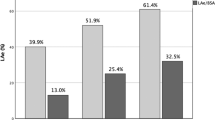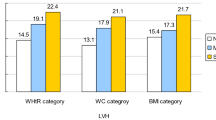Abstract
Whether left ventricular mass (LVM) should be normalized to different indexes in relation to body size is still debated. We sought to evaluate the prevalence of left ventricular hypertrophy (LVH) defined by different indexation criteria in a cohort of hypertensive subjects categorized according to body mass index (BMI). A total of 2213 essential hypertensive subjects included in the Evaluation of Target Organ Damage in Hypertension (ETODH) were divided in three groups according to BMI thresholds (<25, 25–29.9 and ⩾30 kg m−2). All patients underwent extensive investigations including quantitative echocardiography. LVH was defined as an LVM index equal to or higher than (1) 125 g m−2 in men and 110 g m−2 in women, (2) 51 g m−2.7 in men and 47 g m−2.7 in women. Overall, 687 out of 2213 patients (31.0%) were found to have LVH when LVM was indexed to body surface area (BSA) and 1030 (46.5%) when indexed to height2.7. A total of 845 patients (38.2%) had normal BMI, 954 patients (43.1%) were overweight and 414 (18.7%) were obese. Prevalence rates of LVH in the three groups were 25.1, 31.6, 41.2% by indexation to BSA and 29.9, 50.5, 71.8% by indexation to height2.7, respectively. LVM indexed to BSA markedly underestimates LVH prevalence in obese as well as overweight hypertensive patients. To avoid a systematic misclassification of cardiovascular risk, LVM should be routinely indexed to height2.7 in overweight and obese patients representing a large percentage of the hypertensive population.
This is a preview of subscription content, access via your institution
Access options
Subscribe to this journal
Receive 12 digital issues and online access to articles
$119.00 per year
only $9.92 per issue
Buy this article
- Purchase on Springer Link
- Instant access to full article PDF
Prices may be subject to local taxes which are calculated during checkout

Similar content being viewed by others
References
Vakili BA, Okin PM, Devereux RB . Prognostic implications of left ventricular hypertrophy. Am Heart J 2001; 141: 334–341.
Levy D, Garrison RJ, Savage DD, Kannel WB, Castelli W . Prognostic implications of echocardiographically-determined left ventricular mass in the Framingham Study. N Engl J Med 1990; 322: 1561–1566.
Koren MJ, Devereux RB, Casale PN, Savage DD, Laragh JH . Relation of left ventricular mass and geometry to morbidity and mortality in uncomplicated essential hypertension. Ann Med Intern 1991; 114: 345–352.
Liao Y, Cooper RS, McGee DL, Mensah GA, Ghali JK . The relative effects of left ventricular hypertrophy, coronary artery disease, and ventricular dysfunction on survival among black adults. JAMA 1995; 273: 1592–1597.
Kaplan N, Mendis S, Poulter N, Whitworth J, World Health Organization, International Society of Hypertension Writing Group. 2003 World Health Organization (WHO)/International Society of Hypertension (ISH) statement of hypertension. World Health Organization, International Society of Hypertension Writing Group. J Hypertens 2003; 21: 1983–1992.
Chobanian AV, Bakris GL, Black HR, Cushman WC, Green LA, Izzo Jr JL, et al., National High Blood Pressure Education Program Coordinating Committee. The seventh report of the Joint National Committee on Prevention, Detection, Evaluation, and Treatment of High Blood Pressure. The JNC 7 report. JAMA 2003; 289: 2560–2572.
Mancia G, De Backer G, Dominiczak A, Cifkova R, Fagard R, Germano G et al. 2007 Guidelines for the Management of Arterial Hypertension. The Task Force for the Management of Arterial Hypertension of the European Society of Hypertension (ESH) and of the European Society of Cardiology (ESC). J Hypertens 2007; 25: 1105–1187.
Doll S, Paccaud F, Bovet P, Burnier M, Wietlisbach V . Body mass index, abdominal adiposity and blood pressure consistency of their association across developing and developed countries. Int J Obes Relat Metab Disord 2002; 26: 48–57.
Lauer MS, Anderson KM, Levy D . Separate and joint influences of obesity and mild hypertension on left ventricular mass and geometry: the Framingham Heart Study. J Am Coll Cardiol 1992; 19: 130–134.
de Simone G . State of the art in the metabolic syndrome. Nutr Metab Cardiovasc Dis 2005; 15: 239–241.
Corry DB, Tuck AM . Obesity, hypertension and sympathetic nervous system activity. Curr Hypertens Rep 1998; 1: 119–126.
Levy D, Labib SB, Anderson KM, Christiansen JC, Kannel WB, Castelli WP . Determinants of sensitivity and specificity of electrocardiographic criteria for left ventricular hypertrophy. Circulation 1990; 81: 815–820.
de Simone G, Kizer JR, Chinali M, Roman MJ, Bella JN, Best LG, et al., for the Strong Heart Study Investigators. Normalization for body size and population attributable risk of left ventricular hypertrophy. Am J Hypertens 2005; 18: 191–196.
Chalmers A, Mac-Mahon S, Mancia G, Whitworth J, Beilin L, Hansson L et al. 1999 World Health Organization–International Society of Hypertension Guidelines for the Management of Hypertension. Guidelines Subcommittee. J Hypertens 1999; 17: 151–183.
Zanchetti A, Cifkova R, Fagard R, Kjeldsen S, Mancia G, Poulter N et al. European Society of Hypertension-European Society of Cardiology Guidelines Committee. 2003 European Society of Hypertension/European Society of Cardiology guidelines for the management of arterial hypertension. Guidelines Committee. J Hypertens 2003; 21: 1011–1053.
Pi-Sunyer FX . Clinical guidelines on the identification, evaluation, and treatment of overweight and obesity in adults—the evidence report. National Institutes of Health. Obes Res 1998; 6 (Suppl 2): 51S–209S.
Cuspidi C, Meani S, Fusi V, Valerio C, Catini E, Sala C et al. Prevalence and correlates of left atrial enlargement in essential hypertension: role of ventricular geometry and the metabolic syndrome. The Evaluation of Target Organ Damage in Hypertension study. J Hypertens 2005; 23: 875–882.
Devereux RB, Reichek N . Echocardiographic determination of left ventricular mass in man. Anatomic validation of the method. Circulation 1977; 55: 613–618.
de Simone G, Devereux RB, Daniels SR, Koren MJ, Meyer RA, Laragh JH . Effect of growth on variability of left ventricular mass; assessment of allometric signals in adults and children and their capacity to predict cardiovascular risk. J Am Coll Cardiol 1995; 25: 1056–1062.
Ganau A, Devereux RB, Roman MJ, de Simone G, Pickering TG, Saba PS et al. Patterns of left ventricular geometry and geometric remodelling in essential hypertension. J Am Coll Cardiol 1992; 19: 1550–1558.
Grundy SM, Cleeman JI, Daniels SR, Donato KA, Eckel RH, Franklin BA et al. Diagnosis and management of the metabolic syndrome. An American Heart Association/National Heart, Lung and Blood Institute Scientific Statement. Circulation 2005; 112: 1–18.
Dewey FE, Rosenthal D, Murphy DJ, Froelicher VF, Ashley EA . Does size matter ? Clinical applications of scaling cardiac size and function for body size. Circulation 2008; 117: 2279–2287.
Coca A, Gabriel R, de la Figuera M, Lopez-Sendon JL, Fernandez R, Sagastagoistia JH, et al., on behalf of the VITAE Investigators. The impact of different echocardiographic diagnostic criteria on the prevalence of left ventricular hypertrophy in essential hypertension: the VITAE study. J Hypertens 1999; 17: 1471–1480.
Ferrara LA, Vaccaro O, Cardoni O, Laurenzi M, Mancini M, Zanchetti A . Indexation criteria of ventricular mass and predictive role of blood pressure and body composition. Am J Hypertens 2005; 18: 1282–1287.
Watchell K, Bella JN, Liebson PR, Gerdts E, Dahlof B, Aalto T et al. Impact of different partition values on prevalence of left ventricular hypertrophy and concentric geometry in a large hypertensive population. The LIFE study. Hypertension 2000; 35: 6–12.
Liao Y, Cooper RS, Durazu-Arzivu R, Mensah GA, Ghali JK . Prediction of mortality risk by different methods of indexation for left ventricular mass. J Am Coll Cardiol 1997; 58: 1072–1083.
Bella JN, Devereux RB, Roman MJ, O’Grady MJ, Welty TK, Lee ET, et al., for the Strong Heart Study Investigators. Relations of left ventricular mass to fat-free and adipose body mass: the Strong Heart Study. Circulation 1998; 98: 2538–2544.
De Simone G, Devereux RB, Maggioni AP, Gorini M, de Divitiis O, Verdecchia P . MAVI (Massa Ventricolare sinistra nell’Ipertensione) Study Group. Am J Hypertens 2005; 18: 1288–1293.
Cuspidi C, Esposito A, Negri F, Sala C, Masaidi M, Giudici V et al. Studies on left ventricular hypertrophy regression in arterial hypertension: a clear message for the clinician? Am J Hypertens 2008; 21: 458–463.
Cuspidi C, Valerio C, Sala C, Muiesan ML, Grandi AM, Palumbo G et al., on behalf of the Lombardy Regional Section of the Italian Society of Hypertension. The Hyper-Pract Study: a multicentre survey on the accuracy of the echocardiographic assessment of hypertensive left ventricular hypertrophy in clinical practice. Blood Press 2008; 17: 124–128.
Lang RM, Bierig M, Devereux RB, Flachskampf FA, Foster E, Pellikka PA, et al., Chamber Quantification Writing Group; American Society of Echocardiography's Guidelines and Standards Committee; European Association of Echocardiography. Recommendations for chamber quantification: a report from the American Society of Echocardiography's Guidelines and Chamber Quantification Writing Group, developed in conjunction with the European Association of Echocardiography, a branch of the European Society of Cardiology. J Am Soc Echocardiogr 2005; 18: 1440–1463.
Author information
Authors and Affiliations
Corresponding author
Rights and permissions
About this article
Cite this article
Cuspidi, C., Meani, S., Negri, F. et al. Indexation of left ventricular mass to body surface area and height to allometric power of 2.7: is the difference limited to obese hypertensives?. J Hum Hypertens 23, 728–734 (2009). https://doi.org/10.1038/jhh.2009.16
Received:
Revised:
Accepted:
Published:
Issue Date:
DOI: https://doi.org/10.1038/jhh.2009.16
Keywords
This article is cited by
-
Right atrium size in the general population
Scientific Reports (2021)
-
Height Versus Body Surface Area to Normalize Cardiovascular Measurements in Children Using the Pediatric Heart Network Echocardiographic Z-Score Database
Pediatric Cardiology (2021)
-
Skin autofluorescence is associated with inappropriate left ventricular mass and diastolic dysfunction in subjects at risk for cardiovascular disease
Cardiovascular Diabetology (2017)
-
Geometrical and functional changes of left heart in adults with prehypertension and hypertension: a cross-sectional study from China
BMC Cardiovascular Disorders (2016)
-
Left ventricular mass and systolic function in children with chronic kidney disease—comparing echocardiography with cardiac magnetic resonance imaging
Pediatric Nephrology (2016)



